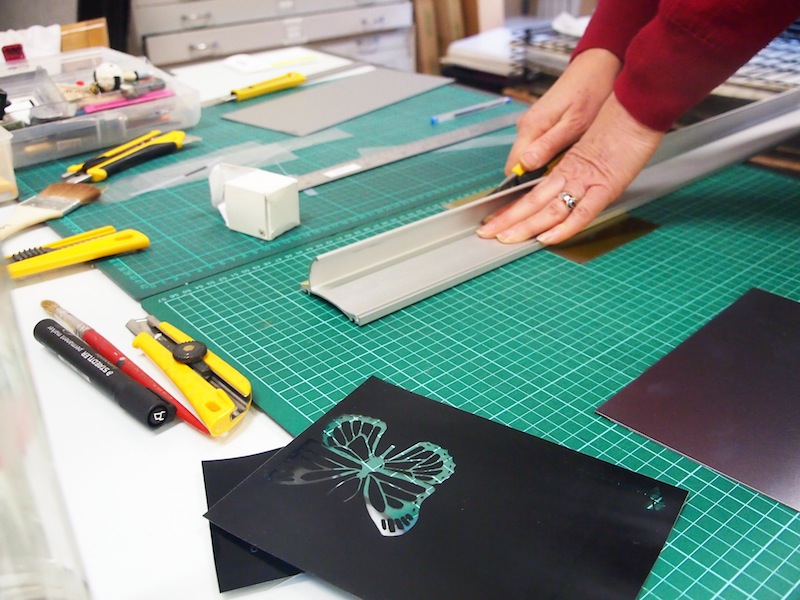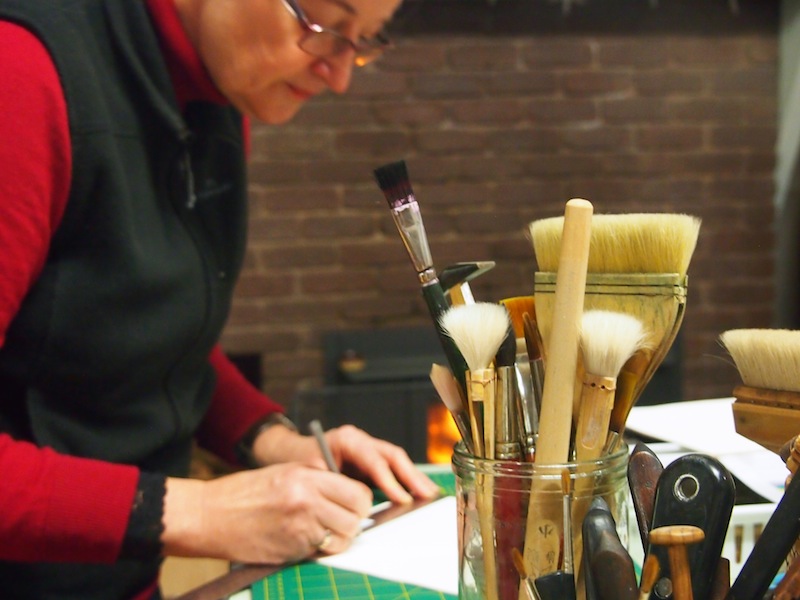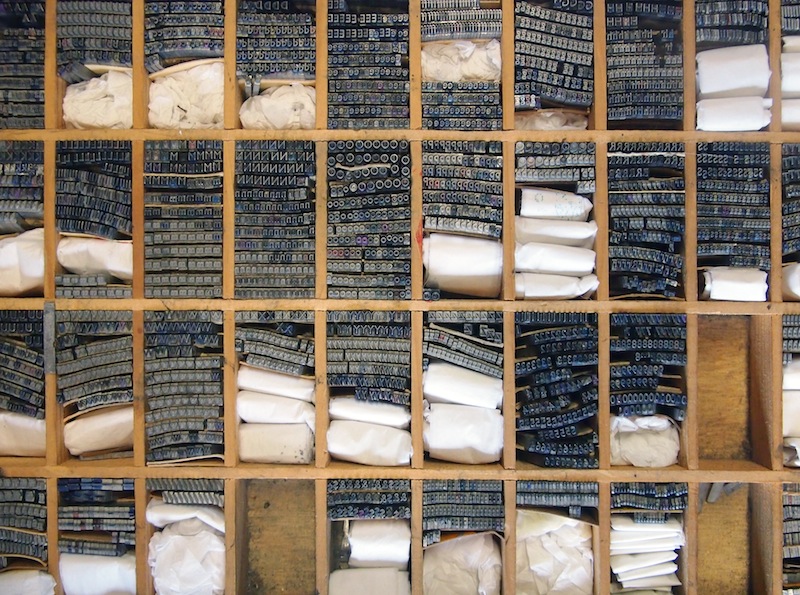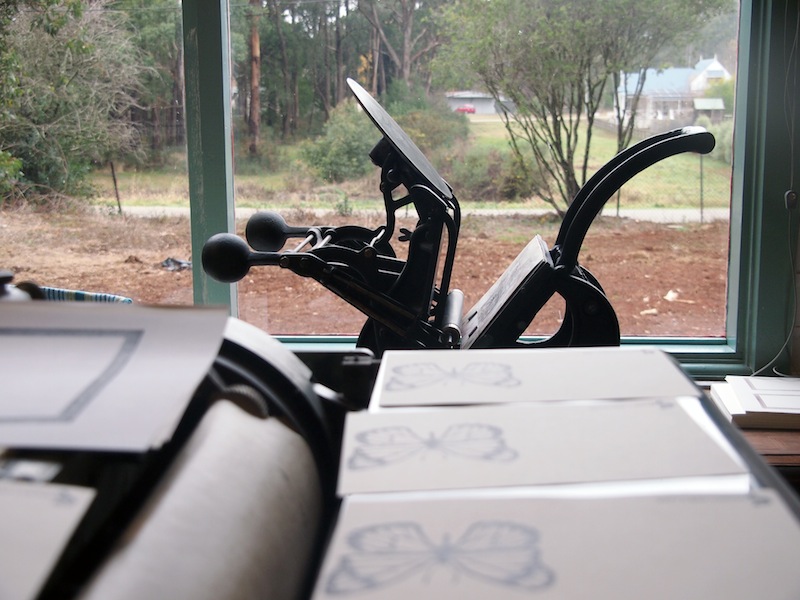Do you want to know how letterpress works?
Every time we learn something new, we gain more than skills and knowledge. Often we gain confidence, or a sense of purpose, or a sense of achievement, or creative inspiration to do more, try more, experience more, learn more. Learning brings SO MUCH GOOD, even learning things we don’t necessarily want to learn, or think we need.
Like that time my friend Cara was having a birthday and she had always wanted to learn the trapeze so I bought her trapeze lessons… and then she insisted that I be her buddy (because the lessons were for two). And I didn’t want to do it because learning the trapeze was her dream, not mine, and, if we were going to get down to the nitty-gritty, I was afraid. But I loved Cara and Cara wanted the buddy to be me, so off we went on the train, giggling nervously.
And the next minute I was climbing that ladder and it didn’t look so high from the ground but as I was climbing it just kept going up, up, up and by the time I got to the top and was leaning out over the platform waiting to catch a flimsy metal bar as it swung towards me over the abyss (go with me here, I’m talking about FEELINGS), I started shaking uncontrollably. I mean my leg was visibly quivering, like an Elvis dance in fast-forward. And the acrobat behind me was yelling “GO NOW” but I couldn’t make that shaky leg shift, and timing was everything when it came to catching a trapeze, so the next time the swing came back towards me I felt a massive shove behind my knee* and launched forward, catching that bar with my chalky, sweaty hands just as my toes touched air.
It felt like an impossible task but two turns later I was back up that ladder, launching out to catch the bar, swinging myself upside-down to hang by the knees, arching backwards, reaching out, and flying - momentarily - through the air, before catching hold of the strong hands and wrists of somebody else, also upside-down, in a perfect combination of timing and trust.
On the way back home on the train, Cara and I felt invincible. We were gods! We could do anything! And I thought, what am I doing here? I have been talking about moving to New York for SIX YEARS. Why do I keep talking about it? What’s the point of talking? And so that very week I gave notice at my job, bought a plane ticket, and started packing. Sure, I was making an international move with no money, no visa, no job and nowhere to live… but I could FLY. What’s a move to another country, when you put it all into perspective?
So far nothing QUITE so life-changing has followed my lesson in letterpress, but as I drove home through the rain I was reminded of the trapeze lesson all those years ago, because as I drove it was with that same elation of having learned something new, having set myself a task and achieved it, and of having new creative opportunities opened up to me. And just like the trapeze, I never would have done this without a bit of a shove.
In the lead-up to Mother’s Day we did that old dance, the one where Mr B says “What would you like?” and I say “I don’t need anything, just let’s go out to lunch and spend time together as a family,” and I mean it because OF COURSE there are lots of things I would like: I’d like a pony, for instance, also a million dollars, but, well, you get my drift. And then his face lit up and he said “I know!” and he pulled out his iPad and before I knew what was going on, Mr B had sent off an email to Dianne Longley, who he had met at the Lost Trades Fair, asking her about giving me a private lesson in how letterpress works, and helping me understand what methods I might want to pursue. It was done before I knew what it was, and a few weeks later I found myself driving alone through rain and fog to Dianne’s wonderful, warm studio up in the Central Highlands of Victoria, ready to spend a day of learning.
I’ve often wondered, not in a keep-you-up-at-night way but definitely in a passing “wait a minute” way, how all those letterpress cards you see with beautiful, whimsical drawings work. I mean, my understanding of letterpress was that it was a mini printing press, right? So you place all those little metal letters into reverse order, ink up a plate, and press them through the ink onto the paper. So… how do they get the drawings?
The night before my lesson, I sketched up a picture of a butterfly that I wanted to use on the cover of my little zine on practising kindness (the butterfly effect, you know?), and brought it with me, just in case. With Dianne’s help, I created several covers of the zine, which I’ll start sending out to people soon. (Once it was printed I realised I’d made the butterfly too big, and too close to the edge of the page. If you get one of these, you’ll be holding onto my FIRST EVER letterpress attempts, so please forgive me my mistakes in the learning process).
In case you’re wondering too, here’s what you have to do to turn a picture of a butterfly into the cover of a zine, using letterpress (the basic version):
1. Scan the drawing in very high res, then open it up in an editing program 2. Reverse the image so it looks like a negative 3. Print the negative image onto clear plastic (like one of those overhead-projector sheets) 4. Cut out a piece of photopolymer plate slightly smaller than your drawing, place the drawing on top of the plate, then expose it to UV rays. You can do this outside on a sunny day, or use a UV light box. The light will burn away the negative parts of the image, creating a relief in the shape of your original drawing 5. Gently wash away the residue from your plate, in a basin of lukewarm water 6. At this next stage, Dianne put the plate in some other kind of machine for a few minutes to harden it. I can’t remember what that was 7. Depending on how many prints you want to make, you’ll choose your letterpress machine. I had unwittingly drawn my butterfly a few millimetres too big to use the antique tabletop platen press one would usually use for a job like this. So instead, we mixed up some ink with fixer, and used a bayer (roller) to evenly cover the plate with ink. Then I carefully positioned my paper over the plate, and pressed it all between some sheets of thick cardboard in an antique, cast-iron book-press. Doing this one at a time was pretty slow, but I was only making a few covers so that was OK
The end. You can see my butterfly print in the photographs above.
I was so inspired by this lesson (learning does that, I told you!), and I am saving up for another lesson. The next time, I’ll hone my drawing for the cover, AND I want to print it onto thicker paper-stock to get that embossed feeling that I love about letterpress (incidentally, Dianne told me the embossing/de-bossing is a modern phenomenon: way back when, that was considered a mistake, which makes sense when you consider letterpresses were used to print entire books), and Dianne tells me we might be able to letterpress my entire zine!
What about you? Have you learned anything new lately?
* The next day later, wondering why I felt so stiff and sore behind my knees, I looked and found big bruises where they had actually kicked me to make sure I leapt off that platform in time!










